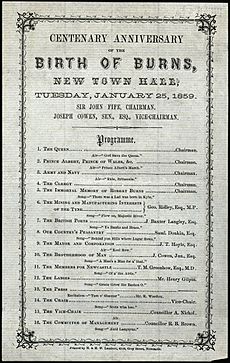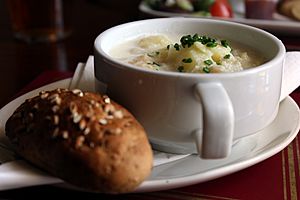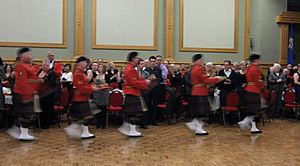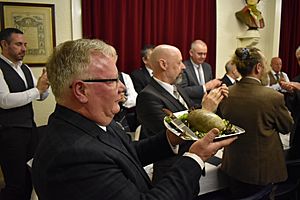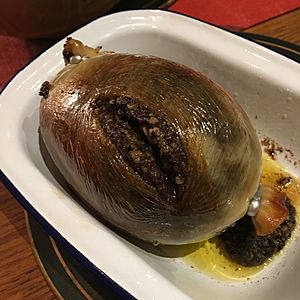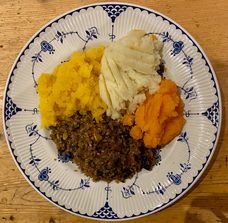Burns supper facts for kids
Quick facts for kids Burns Night |
|
|---|---|
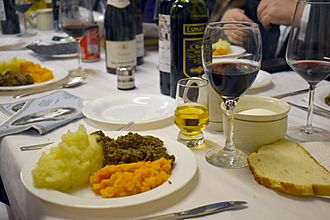
The traditional meal of haggis, neeps and tatties at Dundee Burns Club's 160th annual Burns supper, on 25 January 2020
|
|
| Observed by | Scotland; Scots people |
| Date | 25 January (traditional) |
| Frequency | Annual |
A Burns supper is a special meal that celebrates the life and poems of Robert Burns. He was a famous poet from Scotland who wrote many poems in the Scots language.
These suppers usually happen on or near his birthday, January 25th. This day is known as Burns Night. People all over the world, especially those with Scottish roots, hold Burns suppers to honor him.
Contents
History of the Celebration
The very first Burns supper was held by the poet's friends in 1801. It took place at Burns Cottage in Ayrshire, Scotland. This was on the fifth anniversary of his death.
The first Burns Club was started in Greenock in 1801. The members held their first supper in 1802. They thought Burns's birthday was January 29th. But a year later, they found records showing he was born on January 25th, 1759. Since then, the celebrations have been held on January 25th.
The Scottish Parliament sees Burns Night as a very important cultural event. It's a chance to celebrate the Scots language and Scotland's national poet.
What Happens at a Burns Supper?
A Burns supper can be a big, formal event or a small, casual get-together. But both types usually include three key things:
- Haggis, a traditional Scottish food.
- A traditional Scottish drink for the adults.
- Readings of Robert Burns's famous poems.
Formal dinners often end with Scottish dancing, called a cèilidh. Here is the usual order of events for a formal Burns supper.
Guests Arrive
As guests arrive, a bagpiper might play to welcome them. At smaller parties, other traditional Scottish music is often played. The host gives a speech to welcome everyone.
After everyone is seated, a special prayer called the Selkirk Grace is said. It's a way of giving thanks for the meal in the Scots language.
The Selkirk Grace
- Some hae meat an canna eat,
- And some wad eat that want it;
- But we hae meat, and we can eat,
- And sae the Lord be thankit.
This means: "Some have food but cannot eat, and some would eat but have none. But we have food, and we can eat, and so we thank the Lord."
The Meal Begins
The supper starts with a soup. Popular choices are Scotch broth, potato soup, or cock-a-leekie (chicken and leek soup).
The Famous Haggis
The most exciting part of the night is the arrival of the haggis. Everyone stands up as the cook brings it in on a large platter. A bagpiper often leads the way, playing a special tune.
The host or a guest then recites a famous poem by Burns called Address to a Haggis.
"Address to a Haggis"
This poem is a fun and dramatic tribute to the haggis. As the poem is read, the speaker acts it out. When they reach the line "His knife see rustic Labour dicht" (meaning "see the worker wipe his knife"), they pull out a knife.
At the line "An' cut you up wi' ready slicht" (meaning "and cut you up with skill"), the speaker cuts the haggis open. It's a big moment and a highlight of the evening!
Below is the poem in its original Scots language, with an English translation.
| Original text | English translation |
|
Fair fa' your honest, sonsie face, |
Nice seeing your honest, chubby face, |
|
The groaning trencher there ye fill, |
The groaning platter there you fill, |
|
His knife see rustic Labour dicht, |
His knife see the worker sharpen, |
|
Then, horn for horn, they stretch an' strive: |
Then, spoon for spoon, they stretch and strive: |
|
Is there that o're his French ragout |
Is there anyone, who over his French stew, |
|
Poor devil! see him ower his trash, |
Poor devil! See him over his trash, |
|
But mark the Rustic, haggis fed, |
But look at the countryman, fed on haggis, |
|
Ye Pow'rs wha mak mankind your care, |
You Powers, who make mankind your care, |
The Main Course
After the poem, a toast is made to the haggis. Then, everyone sits down to eat. Haggis is traditionally served with "tatties" and "neeps."
"Tatties" are mashed potatoes. "Neeps" are mashed swede (a root vegetable similar to a turnip). Vegetarian haggis is also very popular.
After the main course, guests might have a dessert like cranachan (a dessert with oats, cream, and raspberries).
Speeches and Toasts
After the meal, it's time for speeches.
- The Immortal Memory: A speaker gives a speech about Robert Burns's life or poems. Everyone then raises a glass and toasts to the "Immortal Memory" of the poet.
- Address to the Lassies: A male guest gives a funny speech about his views on women. The men then toast to the health of the women.
- Reply to the Laddies: A female guest gives a speech in reply. She shares her views on men and responds to the previous speaker. It's all done in good fun.
Entertainment and Closing
The evening continues with more of Burns's work. Guests might sing his songs, like "Ae Fond Kiss" or "A Man's A Man for A' That." They might also read more of his poems, such as "To a Mouse" or "Tam o' Shanter".
To end the night, everyone stands, joins hands, and sings "Auld Lang Syne". This is one of Burns's most famous songs, sung around the world on New Year's Eve.
Images for kids
See also
 In Spanish: Noche de Burns para niños
In Spanish: Noche de Burns para niños



